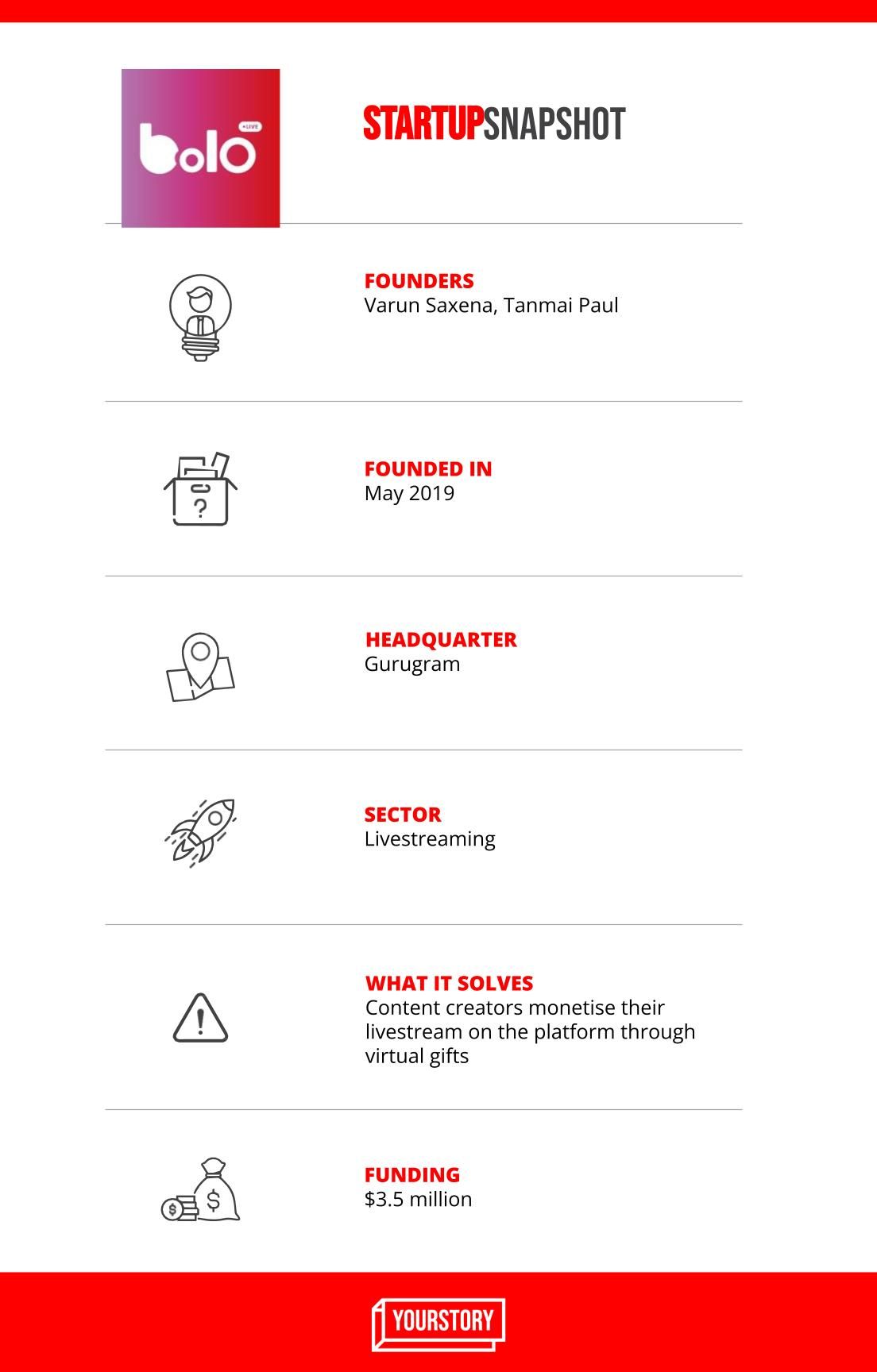When (previously known as Bolo Indya) started in May 2019, it was positioned as a competitor to ByteDance-backed short video app TikTok. After TikTok was banned in June 2020, a flurry of Indian-origin short video apps stepped in to fill the void, with Mohalla Tech’s Moj, VerSe Innovations backed Josh, and MX TakaTak emerging as strong contenders.
Bolo Live also started pivoting to a live-streaming model later that year as monetisation became a challenge, with well-funded competitors beginning to dominate the market.
“When we started, we used to let creators monetise their content on closed room discussions and live sessions as part of Bolo.me. These were pay-per-use sessions and the audience would pay for them ahead of the session. We were exploring multiple ways to monetise the platform,” Varun Saxena, Co-founder and CEO of Bolo Live, told YourStory.
The startup decided to scale its live content feature to all the creators, similar to the Chinese live streaming app Kuaishou, backed by Tencent.
“We have seen how a platform like Kuaishou in China can be a close competitor ByteDance’s TikTok, and that live streaming can drive success for users and content creators,” adds Varun.
Money matters
The process of moving to live streaming, which started in October 2020, was completed four months later with some loss in viewership. Retaining content creators was also a major challenge. Varun adds,
“When we were doing short videos retaining content creators was a challenge, especially with bigger competitors spending more money. We had a retention rate of nearly 25 percent which has now improved to nearly 80 percent with the switch to live video.”
The pivot has also meant better payouts for content creators, thereby ensuring stickiness. On the Bolo Live platform, the audience or users can buy ‘virtual gifts’ for creators during a live session through micro-payment on the platform.
The creator can look to track the rewards and corresponding payouts on their dashboard and choose to encash part or all of it directly into their digital wallet or bank accounts. For content creators who work with talent agencies, they pay them a fee – apart from the commission charged by Bolo Live’s platform which is deducted during the payout as well as the platform fee charged by Google Play Store or by Apple App Store.
The platform claims to host 1.2 lakh active content creators, the majority of whom create content in Hindi, and hail from states of Uttar Pradesh, Bihar, Madhya Pradesh, and Rajasthan. These active creators go live on the platform at least once a week, with most of them hosting sessions ranging from 10 minutes to nearly 120 minutes in the field of entertainment. Singing is the most popular sub-category in entertainment watched by the audiences. Entertainment is followed by life experiences, astrology, fitness, and other categories in terms of popularity.
Bolo Live currently has 22 creators who make over Rs 1 lakh per month from virtual gifts from their audiences. The app claims to have seen an 8X jump in revenue year-on-year at $1.3 million for FY 2021-22.
Tapping into gaming
While the audience on Bolo Live’s platform enjoy watching content creators sing, Varun says that other white spaces can also be filled by the live streaming service. The platform is betting heavily on social gaming for the coming year.
“A basic example of social games could be people playing Antakshari, where a creator takes multiple audience members on a live video call – a feature which exists on the Bolo Live platform,” says Varun. He adds that the platform also features other formats such as quizzes and real-time knockout sessions between two top players or participants.
Varun adds that the rise in the number of micro-transactions and the ease of payment as well as audience trust will play a major role in helping them grow the monetisation channel.
The app is also looking to introduce a subscription service for the audience to reach out or connect with the content creators. “The audience will be able to consume some content from the creator even when they are not live on the platform. It could also be audiences reaching out to creators with a question, which they can pay to get answered, among other formats,” says Varun.

Snapshot of Bolo Live
The platform had recently raised $2.4 million from Orios Venture Partners, SOSV, and others. The platform also plans on raising a Series A round later this year.
In China, a primary mode of monetisation for live streaming platforms is skewed towards video commerce, with content creators and influencers selling products to audiences in real-time through shoppable links. India is catching up on the trend with ecommerce players such as Amazon and Flipkart experimenting with these formats. According to a recent report, Amazon is in talks with influencer-led social commerce platform Trell to mark its foray into video-based commerce.
Given this progression, Varun does not write off the entry of Bolo Live into video-based commerce, though it is still some time away. “Today most of the gamers make money from their fans on gaming apps. This goes in line with our monetisation vision and helps us in competing with other apps,” signs off Varun.
Edited by Kanishk Singh


